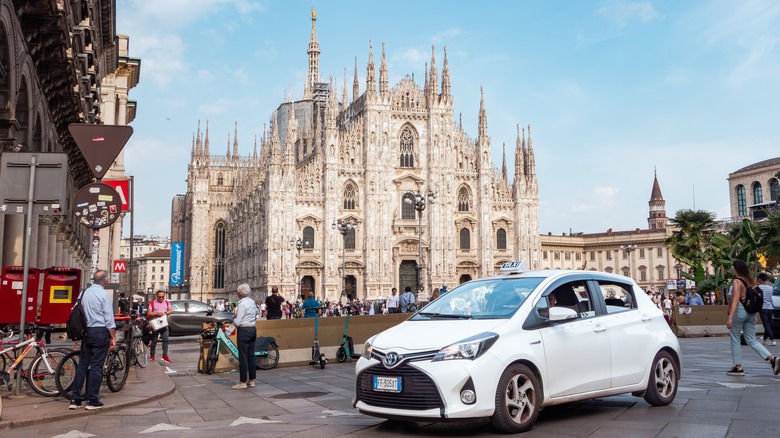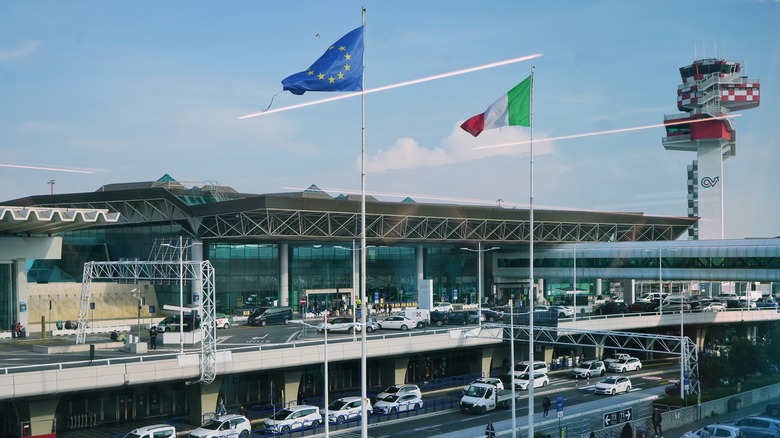Tourists In Italy Should Know This Simple Way To Tell If A Taxi Is Legit Or A Scam
Taxi scams are prevalent in most major cities, and if you've been overcharged by an unofficial driver, you know how frustrating it can be. In your own city, you probably recognize what an official taxi looks like, but what if you're traveling overseas? No one wants to get taken for a ride, so to speak. Before you travel to a new country, it's important to know what you're looking for, as well as the rules and customs, because it's easy to make big transportation mistakes. For example, in Italy, there is a standard look for official taxis, which is white with a meter you can see, a price list, and a visible license. If you don't see any of these things, don't take the ride.
That isn't all there is to it, however. You need to know where to get them, how you can find one when you're not at the airport, and all the info about flat fares. There are standard extra charges in some cases, laws about what can be charged in certain places, and a different tipping culture. It's especially important when there is a language barrier to consider. The good news is, we have the info you need to know about getting a taxi in Italy and how to avoid being scammed.
It's best to head to an official taxi stand in Italy
The easiest place to get a taxi (and to get taken in by a fake one) is at the airport. You're likely to have someone come up to you to offer you a ride or yell "taxi" at you as you go by. They may offer you a better deal and reduced fare, but they're likely taking advantage of you. Like other major airports around the world, you should go to the official taxi stand with a sign for "taxi" displayed. (The word is the same in Italian as it is in English, but if you have any trouble reading signs, download the stress-free Google Translate app and hover the camera over them for instant translation.)
They'll have a posted sign with the flat fares when you're taking a taxi from Leonardo da Vinci–Rome Fiumicino Airport to the city center or inside the Aurelian Walls, which were built in Rome in the 3rd century C.E. by Emperor Aurelian. (Call your hotel to ask if it's inside the walls.) The flat fare from Fiumicino is €45 (around $49), but only if they say "Comune di Roma" on the side. However, if they say "Comune di Fiumicino," they come from that city and they can charge €60 (around $65) to the city center/inside the walls. Luggage is included in the airport price. Check flat fares at other airports you may be traveling from.
Extra charges, starting with a balance, and more taxi info
Outside of flat fares and taxi stands (which you'll also find at many tourist sites), you can call a taxi or use the FreeNow or WeTaxi apps. Note that, in Italy, taxis aren't supposed to stop for people waving them down. You may notice that there is a small fare on there already. The rule in Italy is that the driver starts the meter when you call, not when you get in. If the driver says the meter is broken, don't ride. It's also a good idea to have the address you're going to written down in Italian so you can hand it to the driver. You can ask your hotel concierge to write it for you.
There can be some surcharges and they're different at different times of the day and week. For instance, from 7 a.m. to 10 a.m., you'll have an additional €2.80 (just over $3), which goes up to €4 (just over $4) on Sunday, and €5.80 (just over $6) at night at the time of this writing, plus a €1 (just over $1) charge per piece of luggage. It's a good idea to carry smaller bills in cash with you because a common scam is the driver saying they don't have change if you're waving around a large bill. Finally, you don't have to tip the way you do in America. Rounding up a bill and adding €1 or €2 for luggage help is acceptable.


